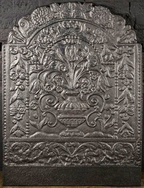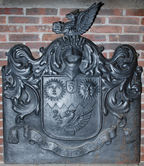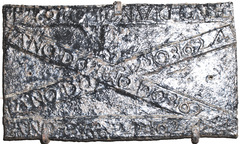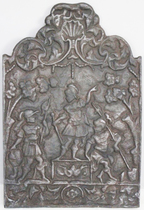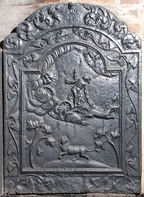-
1141
Description: Arched rectangular shape; twisted rope edging (top and sides); date stamp, 1634, in arch; initials, EH, separated by a cross, below date.
Notes: The same date stamp has been noted on another fireback; the cross between the initials may have an apotropaic purpose.
Inscription: 1634 /E + H
- Decoration tags:
- rectangular with round arch (shape)
- rope (edging)
- simple stamps
- individual letters
- date stamp
- apotropaic
- text
- objects
Manufactured: in 1634 in England.
Current location: Newark Park, Ozleworth, Gloucestershire, England.
(part of the National Trust museum group)
- Attached to series:
- Date & initials firebacks
- 1634 stamp series
-
1068
Description: Arched shape with forward-facing 'wings', which splay outwards towards the base, curved to follow the shape of the main panel; central panel with stylised tree decoration surmounted with a scallop shell between six 'leaves' (one damaged).
Notes: Nothing is known about the sources of free-standing firebacks or what prompted their production. Their form is similar and the predominant use of horticultural or arboreal decorative themes suggests production within a limited time frame. Only a very small number of such castings are known. This fireback casting was probably cast in an open box mould as the upcast (reverse) side of the casting shows evidence of being sand-treated. Depth 200mm.
- Decoration tags:
- free-standing (shape)
- none (edging)
- whole carved pattern
- plants
Manufactured: in the late-17th to early-18th century in England.
Current location: not known.
- Attached to series:
- Free-standing firebacks
-
1161
Description: Arched rectangular central panel with bead-and-pellet edging (top and sides); on a ground between two plants, their flowers upstanding, a gadrooned flower vase with two, scrolled handles, tulips and other flowers issuing from the narrow neck; arched rectangular border with fillet edging; mirrored descending flower swags; along a rectangular bottom panel with fillet edging a symmetrical arrangement of swirled foliage; on top, two mirrored sea serpents; at the sides, a narrow vertical extension bordered with a fillet and with bead infill; at the base, a plain extension panel.
Notes: The presence of tulips suggest a Dutch origin for the pattern of this fireback, although the presence of several examples in England suggest that it was produced there rather than on the Continent. One of several very similar designs, varied by the forms of the vases, the style of the flowers and by their dimensions.
Copies of this fireback are known.
- Decoration tags:
- 'Dutch' (shape)
- fillet (edging)
- whole carved pattern
- extension panels
- pictorial
- plants
- objects
Manufactured: in the late-17th century in England.
Current location: not known.
- Attached to series:
- Flower Vase 'Dutch' types
- British 'Dutch' style firebacks
-
506
Description: Plain rectangular shield with sloping edges; shield helm and crest of Sir Weetman Pearson Bt.: Per fess indented gules and or, between two suns in splendour in chief an escutcheon bearing a baronet's badge, and a demi-gryphon couped wings elevated and addorsed in base all counterchanged; crest: in front of a demi-gryphon as in the arms, holding between the claws a mill-stone proper, thereon a mill-rind sable, a sun in splendour.
Notes: Sir Weetman Pearson, later Viscount Cowdray, was created Baronet in 1894 and Baron in 1910, the fireback thus dates from the period 1894-1910. The motto - Do it with thy might - is from Ecclesiastes 9: 10.
Copies of this fireback are known.
Inscription: DO IT WITH THY MIGHT
Arms: Sir Weetman Pearson Bt
- Decoration tags:
- complex individual (shape)
- none (edging)
- whole carved pattern
- armorial
- text
Manufactured: in the late-19th century in England.
Current location: Parham House, Parham, West Sussex, England.
- Attached to series:
- Personal armorial firebacks
-
507
Description: Low arched rectangle with stepped shoulders; cavetto moulded edging; Stuart royal shield with lion and unicorn supporters, garter and crown.
Notes: The pattern was probably carved in high relief, but the depth of casting sand may have been insufficient for all the detail to be revealed. At least one horizontal plank line is visible.
Copies of this fireback are known.
Arms: English Stuart royal
- Decoration tags:
- rectangular with round arch (shape)
- rebated fillet (edging)
- whole carved pattern
- planklines
- armorial
- royal
Manufactured: in the late-17th to early-18th century in England.
Current location: Parham House, Parham, West Sussex, England.
- Attached to series:
- Stuart royal armorial firebacks
-
1293
Description: Rectangular shape; no edging; raised fillets along the top and bottom, and diagonally in both directions between them, upon each of which are embossed ANO DO ANO DO 1624, although the spacing differs on each fillet, the certainty of this repetition is concealed in some parts by indistinct casting, and in at least one instance a colon is inserted before the date. The inscription on the top edge is inverted. Behind the intersection of the two diagonal fillets is what might be a figure holding a linear object over its right shoulder.
Notes: Clearly intended to be commemorative although for what is not known. Its small dimensions indicate that could have been intended as a plaque rather than a fireback, although the indistinct inscription on the bottom edge could have resulted from corrosion by fire.
Inscription: ANO DO ANO DO [:] 1624 [x4]
- Decoration tags:
- rectangular (shape)
- none (edging)
- carved stamps
- individual letters
- individual numbers
- text
- humans
Manufactured: in 1624 possibly in the Weald area of England.
Current location: Parham House, Parham, West Sussex, England.
- Attached to series:
- Miscellaneous stamp firebacks
-
1294
Description: Rectangular shape; cavetto-moulded edging (top and sides only); top left, initials IL and top right, 1697.
Notes: The style of lettering and numerals indicate that this is a casting from a larger group produced between the late-1660s and late 1690s.
Inscription: IL 1697
- Decoration tags:
- rectangular (shape)
- cavetto (edging)
- carved stamps
- individual letters
- individual numbers
- text
Manufactured: in 1697 in the Weald area of England.
Current location: Parham House, Parham, West Sussex, England.
- Attached to series:
- 1660s-90s Wealden series
- Date & initials firebacks
-
211
Description: Rectangular with arched, mirrored, scrolls on top, a cartouche scallop shell between; fillet edging; between two trees, three soldiers in Roman dress, holding either pikes, swords or shields, one on a plinth; at the bottom, a separate rectangular panel with mirrored scrolled foliage.
Notes: Possibly intended to represent the Horatii who, according to Livy, defeated the Curiatii.
Copies of this fireback are known.
- Decoration tags:
- rectangular with ornate arch (shape)
- fillet (edging)
- whole carved pattern
- pictorial
- mythological
- humans
Manufactured: in the early-18th century in England.
Current location: Kernow Furniture, Penhalvean Pottery, Penhalvean, Cornwall, England.
- Attached to series:
- Late pictorial series (all)
- Late pictorial series 4
-
509
Description: Arched rectangular central panel with astragal and fillet edging; Phaëton riding Apollo’s chariot across the skies, the sun to the left behind clouds, a lion on ground below, between two trees; arched rectangular border with fillet edging; trailing convolvulus leaves surround the central panel; on top, earl’s coronet above an illegible character, between mirrored, swirled foliage.
Notes: The illustration upon which the design has been based has not been identified, save that it figures in book II of Ovid's Metamorphoses. The convolvulus border is a common feature of this series of firebacks and can be compared with other. The wooden pattern from which this casting was made survives in the collection of the Sussex Archaeological Society (no. 928).
- Decoration tags:
- 'Dutch' (shape)
- fillet (edging)
- whole carved pattern
- planklines
- pictorial
- mythological
- animals
- humans
- objects
Manufactured: in the early-18th century at Ashburnham Furnace in the Weald area of England.
Current location: Penhurst Manor, Penhurst, East Sussex, England.
- Attached to series:
- TAN series
- British 'Dutch' style firebacks
-
510
Description: Arched rectangular central panel with astragal and fillet edging; to the left, Æneäs carrying his father, Anchises; to the right, an arched gateway and portcullis beneath battlements with flames rising therefrom; above left, clouds; far left, a tree; arched rectangular border with fillet edging; trailing convolvulus leaves surround the central panel; plain rectangular extensions to the bottom and each side; on top, mirrored, swirled foliage.
Notes: Many of the early illustrated editions of Ovid’s Metamorphoses show Æneäs escaping from burning Troy, with his father on his back, most of them with an archway in the background.
Copies of this fireback are known.
Inscription: TAN
- Decoration tags:
- 'Dutch' (shape)
- fillet (edging)
- whole carved pattern
- planklines
- extension panels
- pictorial
- mythological
- architectural
- monogram
- text
- humans
Manufactured: in the early-18th century at Ashburnham Furnace in the Weald area of England.
Current location: Penhurst Manor, Penhurst, East Sussex, England.
- Attached to series:
- TAN series
- British 'Dutch' style firebacks


